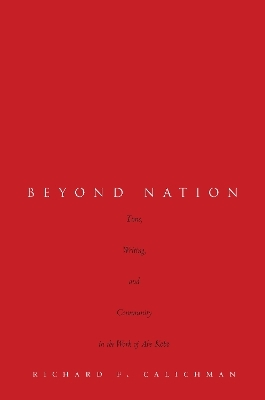
Beyond Nation
Stanford University Press (Verlag)
978-0-8047-9701-6 (ISBN)
Calichman argues that Abe's attack on the concept of national affiliation has been neglected through his inscription as a writer of Japanese literature. At the same time, the institution of Japan Studies works to tighten the bond between nation-state and individual subject. Through Abe's essays and short stories, he shows how the formation of community is constantly displaced by the notions of time and writing. Beyond Nation thus analyzes the elements of Orientalism, culturalism, and racism that often underlie the appeal to collective Japanese identity.
Richard Calichman is Professor of Japanese Studies at The City College of New York and translator of The Frontier Within: Selected Writings of Abe Kōbō (2013).
Contents and AbstractsIntroduction chapter abstractThis chapter introduces the main themes of the book: time, writing, and community. Through a reading of Abe's 1946 poem "Jikan to kūkan" [Time and Space], a notion of ecstatic time is introduced in which succession or temporal movement is made possible on the basis of time standing outside itself. Writing appears as the instance of spatiality or materiality that must remain in order for time to be recognized as such. Finally, the notion of community is explained in such a way as to reveal the manner in which all given communities exist as incessantly exposed to temporal movement and the concomitant threat to identity.
1Markings in the Sand: On Suna no onna chapter abstractThis chapter sets forth the general force of the notion of writing in Suna no onna by conceiving it beyond its conventional determination as an act performed by a human subject. What is most urgently at stake in writing can be approached in the terms of ontology, in which being articulates or determines itself at every moment through a marking that can no longer be understood as purely self-identical. Abe provides an important hint for this rethinking of writing in his repeated references to the concept of time. Writing names an instant of contact or relationality between disparate entities, and this contact leaves behind a trace of itself that can be read thereafter. In this regard, writing points to an impure temporality in which past, present, and future reveal themselves to be strangely interwoven.
2The Time of Disturbance: On "Uchinaru henkyō" chapter abstractThe aim of this chapter is to investigate the relation between time and space in the essay "Uchinaru henkyō." A certain inconsistency is identified in Abe's argument, for he appears at moments to conceive of time as a pure movement that unfolds strictly prior to the intervention of space. This is shown to be impossible, and yet Abe's text also reveals that time and space exist as fundamentally interrelated. This chapter both follows and diverges from Abe to reveal that an entity's exposure to spatiotemporal inscription takes place from the initial moment of its appearance, and it is for this reason that entities are unable to present themselves as such. Although Abe tends to oppose the movement of time to the fixity of space, the notion of alterity he sets forth involves a generalization of movement to include within it space as well as time.
3The Lure of Community in Tanin no kao chapter abstractThis chapter provides a reading of Abe's 1964 novel Tanin no kao through focus on the notion of community. In its traditional determination, community presupposes that identity and difference be conceived as oppositional. For example, the collective identity that grounds communal existence in one case is typically seen as constitutive of its difference from other cases. Abe's dissatisfaction with this understanding finds expression in his attempt to think communal formation on the basis of contingency. What this means, among other things, is that no community can exist as simply given. Here the identity required to form community conceals an even deeper level of identification, and this demands that attention now be directed to the question of ideology.
4Interventions: Of Abe Kōbō chapter abstractThis chapter sets forth the notion of intervention in order to explore the manner in which Abe has been read in the U.S. Japan Studies field. Of central significance is the contradiction in which Abe's attack against the logic of national affiliation has been disavowed through his national inscription as a writer of Japanese literature. Through the example of Abe, this chapter shows that the institution of Japan Studies works to consolidate the hold of nationalism by tightening the bond between nation-state and individual subject. Interpretations of Abe on the part of such scholars as Donald Keene and John Whittier Treat are explored in order to locate a desire for a particularist Japanese identity, one that exists alongside expressions of culturalism, Orientalism, and racism.
Epilogue chapter abstractThis concluding piece begins with a reading of Abe's 1964 short story "Toki no gake" [The Cliffs of Time] in order to set forth the co-implication of life and death. These terms, which can also be understood in terms of the relation between presence and absence, reveal that life is impossible in its immediate positivity. All life, on the contrary, is informed by death or negativity in a manner that must be conceived as original. That is, life when grasped as finite does not simply meet its end in the fact of death; on the contrary, death understood as possibility haunts life from its very inception. This insight is used to analyze certain passages on identity and community as appears in the novel Suna no onna.
| Erscheinungsdatum | 02.03.2016 |
|---|---|
| Verlagsort | Palo Alto |
| Sprache | englisch |
| Maße | 152 x 229 mm |
| Themenwelt | Sachbuch/Ratgeber ► Geschichte / Politik ► Allgemeines / Lexika |
| Geisteswissenschaften ► Geschichte ► Regional- / Ländergeschichte | |
| Geisteswissenschaften ► Sprach- / Literaturwissenschaft ► Anglistik / Amerikanistik | |
| Geisteswissenschaften ► Sprach- / Literaturwissenschaft ► Literaturwissenschaft | |
| ISBN-10 | 0-8047-9701-3 / 0804797013 |
| ISBN-13 | 978-0-8047-9701-6 / 9780804797016 |
| Zustand | Neuware |
| Haben Sie eine Frage zum Produkt? |
aus dem Bereich


